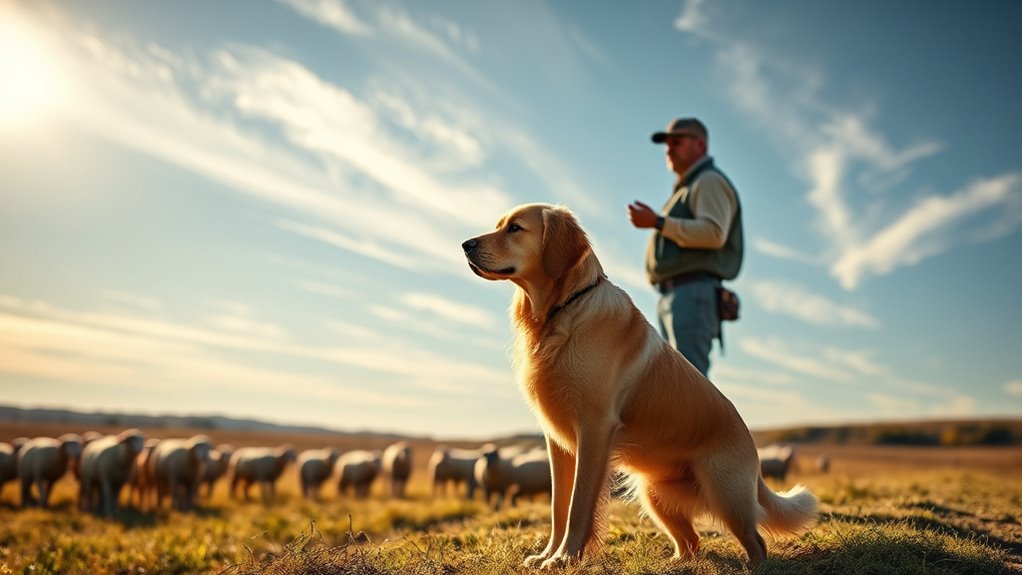To train your farm dog for herding, start with basic obedience commands like sit, stay, and come. Recognize your dog's herding instincts and expose them to livestock early on. Use a leash for controlled introductions, supervising closely and correcting rough behavior immediately. Reinforce positive actions with treats and praise. As your dog masters the basics, gradually increase unsupervised interactions and explore advanced herding techniques. There's much more to discover as you develop their skills.
Key Takeaways
- Start basic obedience training with commands like sit, stay, and come using positive reinforcement techniques.
- Introduce your dog to livestock early, using a leash for control and supervision during initial encounters.
- Observe your dog's herding instincts and tailor training methods to enhance their natural behaviors and abilities.
- Use high-value treats and consistent praise to reinforce positive behaviors and keep training engaging.
- Gradually increase the complexity of commands and unsupervised interactions as your dog demonstrates understanding and control.
Basic Obedience Training

Basic obedience training is essential for your farm dog's safety and your control over their behavior. Start with foundational commands like sit, stay, and come to establish a strong base.
Use consistent verbal commands and hand signals to enhance your dog's understanding. Reinforce good behavior with treats and praise, creating a positive link between obedience and rewards, which motivates your herding dogs to learn.
As they master basic commands, gradually introduce more complex cues like "way for left" or "bye for right." Keep training sessions short—around 5 to 10 minutes—to maintain focus and enthusiasm.
This structured approach guarantees your dog becomes a well-behaved, responsive companion on the farm, ready to assist with herding tasks.
Understanding Herding Instincts
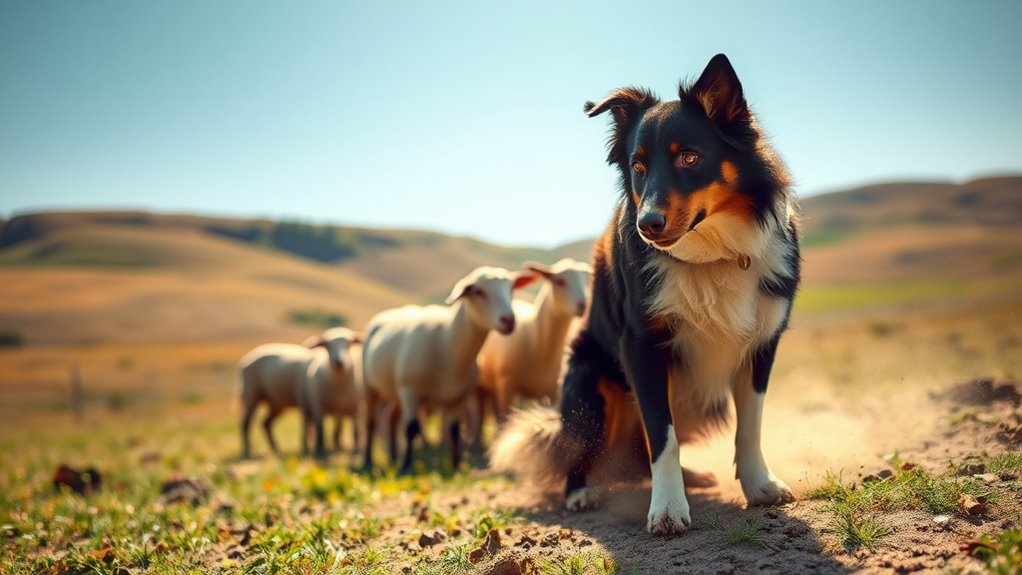
To effectively train your farm dog, you need to recognize their natural herding behaviors and identify if they belong to herding breeds.
Breeds like Border Collies and Australian Shepherds are wired to control livestock, displaying unique traits such as circling and nipping.
Understanding these instincts will help you harness their potential and train them more effectively.
Recognizing Natural Behaviors
Recognizing your farm dog's natural behaviors is key to harnessing their herding instincts effectively. Herding dogs, like Border Collies and Australian Shepherds, often display instinctual actions such as stalking, chasing, and gathering.
By observing these behaviors, you can train your pup to use their instincts positively. Early exposure to livestock is essential; introducing puppies between 8 to 16 weeks can enhance their natural abilities.
Pay attention to your dog's body language—crouching or intense focus signals their herding instincts. Use targeted training commands to guide their actions and reinforce positive behaviors.
Identifying Herding Breeds
Understanding the breeds that excel in herding is essential for anyone looking to train a farm dog effectively.
Recognizing herding breeds helps you leverage their natural instincts and behaviors. Here are three key traits to look for:
- Instinctual Abilities: Breeds like Shepherds, Collies, and Sheepdogs have a strong drive to control livestock movement.
- Unique Behaviors: Watch for circling, stalking, and nipping—these actions indicate your dog's herding instincts are at play.
- Early Socialization: Expose puppies to livestock between 8 to 16 weeks to enhance bonding and training effectiveness.
Introducing Your Dog to Livestock
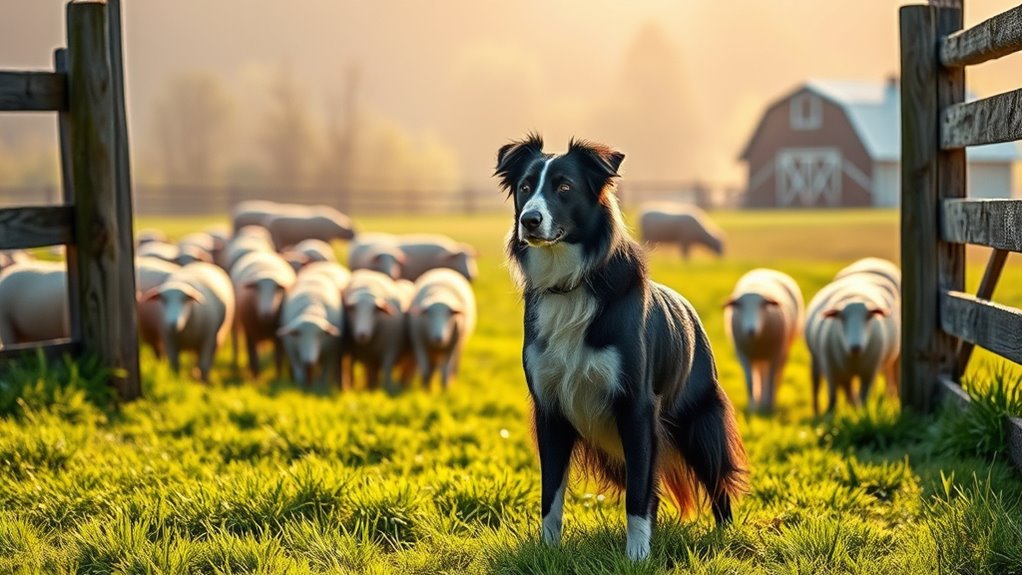
Introducing your dog to livestock at an early age is essential for developing a harmonious relationship between them. Start between 8 to 16 weeks to foster a natural bond and understanding of their role.
Always use a leash during initial introductions to take control and prevent any unwanted chasing or aggressive behavior towards the farm animals. Introduce livestock to your dog one at a time to avoid overwhelming stimuli, allowing for gradual acclimatization.
Supervise all interactions closely; correct any rough behavior immediately and reinforce calm behavior with praise and treats. As your dog becomes more confident and responsive to commands, gradually increase the duration and freedom of their interactions with livestock, ensuring a positive experience for everyone involved.
Controlled Encounters and Supervision
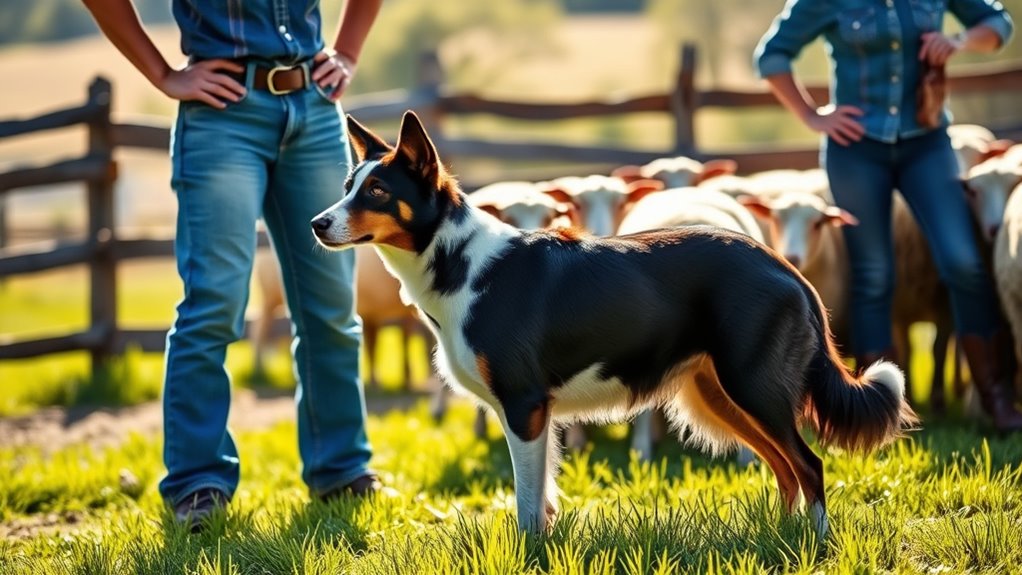
While training your farm dog, controlled encounters with livestock are essential for ensuring safety and fostering proper behavior. During these sessions, supervision is key.
Here's how to manage these interactions effectively:
- Use a Leash: Always introduce your dog to livestock while on a leash to prevent aggressive or overly excited behaviors.
- Have a Helper: A second person can help maintain control; one can focus on the dog while the other manages the livestock.
- Monitor Progress: Gradually increase unsupervised interaction duration as your dog demonstrates desirable behaviors and gains confidence.
Consistent supervision allows you to correct undesirable actions like chasing or roughhousing immediately, creating a positive learning environment for your dog around livestock.
Reinforcing Positive Behaviors

To effectively reinforce positive behaviors in your farm dog, use treats and praise right after they perform the desired action.
This immediate reward helps them connect good behavior with something enjoyable.
Consistent praise also strengthens their learning, making it easier for them to follow commands in the long run.
Use Treats Effectively
One of the most effective ways to motivate your farm dog during herding training is by using high-value treats, like small pieces of cooked chicken or cheese.
These treats serve as positive reinforcement, encouraging your dog to follow commands.
Here's how to use treats effectively:
- Reward Immediately: Give your dog a treat right after they successfully complete a command to reinforce the behavior.
- Incorporate Games: Use treats in fun training games, like fetch, to keep sessions engaging and enjoyable while reinforcing desired behaviors.
- Adjust Frequency: As your dog becomes more proficient, gradually reduce treat frequency, shifting to verbal praise and petting.
Always monitor your dog's weight to guarantee they stay healthy while enjoying their training treats!
Consistent Praise Matters
Using treats effectively is just one part of motivating your farm dog; consistent praise plays an equally important role in reinforcing positive behaviors.
During training sessions, combine verbal affirmations with treats to strengthen your dog's understanding of commands. Positive reinforcement, especially when rewarded immediately after they perform a command correctly, helps build a dog's confidence and encourages them to repeat desired behaviors.
Regularly acknowledging good behavior not only reinforces their learning but also fosters a strong bond between you and your dog, which is essential for effective herding. Additionally, practicing mindfulness techniques during training can enhance your focus and improve your dog's responsiveness.
Gradual Exposure to Larger Herds

As your dog gains control and confidence with smaller animals, it's time to gradually introduce them to larger herds. This process is essential for developing their herding skills without overwhelming them.
Here are three steps to follow:
Here are three essential steps to effectively introduce your dog to larger herds and enhance their herding skills.
- Start Small: Begin with a few larger animals, then slowly increase the size of the herd as your dog adapts.
- Use Commands: Incorporate directional commands like "way" (left) and "bye" (right) to guide your dog effectively.
- Monitor Reactions: Keep a close eye on your dog's behavior, correcting any unwanted chasing or aggression immediately.
Reinforce positive behaviors during these interactions with treats and praise to build their confidence in handling larger herds.
Nutrition and Health Considerations

After your dog has successfully adapted to handling larger herds, it's time to focus on their nutrition and health.
Providing a balanced diet tailored to their energy needs is vital; consider Eukanuba™ Premium Performance 26/16 Exercise dog food for sustained energy and ideal performance.
Regular veterinary check-ups and vaccinations are important to prevent diseases that could hinder your dog's ability to perform on the farm.
Monitor their weight and body condition to guarantee they maintain peak physical fitness for effective herding.
Implement a routine for flea and tick treatments to protect against harmful diseases, and don't forget adequate hydration, especially during training sessions, to support overall health and stamina.
Keeping these factors in check will help your dog excel in herding.
Advanced Herding Techniques
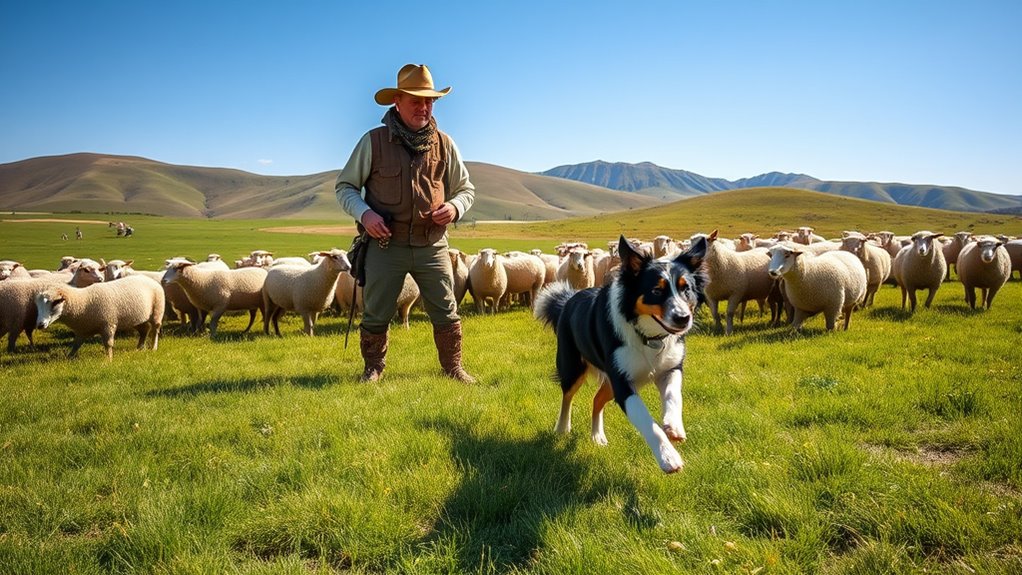
To elevate your dog's herding skills, mastering advanced techniques is vital. These methods harness your dog's natural herding instincts and enhance their effectiveness in real-life herding scenarios.
Here are three key techniques to incorporate:
- Complex Commands: Teach commands like "fetch" to drive livestock toward you and "cast" to gather them together.
- Directional Commands: Use "way" for left and "bye" for right to improve your dog's maneuvering ability.
- Positive Reinforcement: Consistently reinforce commands with praise and treats, as mastery can take time.
Observing your dog's style will help tailor your training approach, ensuring they thrive in various herding situations.
Training Resources and Tools
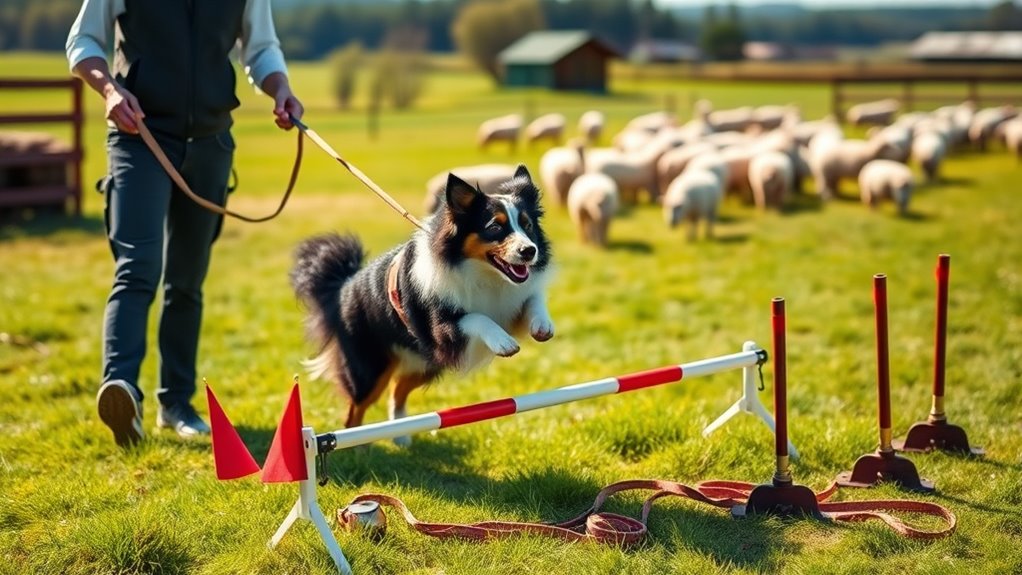
Building on the advanced herding techniques you've learned, having the right resources and tools can greatly enhance your training experience.
Utilize training resources like "Livestock Protection Dogs: Selection, Care and Training" and the Texas A&M Agrilife Extension Guardian Dog Program for expert guidance. Equip yourself with a long lead line for initial training and high-quality puppy food to support your dog's nutrition.
Implement a structured schedule with daily sessions, gradually increasing freedom as your dog understands commands. Use positive reinforcement techniques, including treats and praise, to encourage desired behaviors and build confidence.
Monitor progress closely, and consider corrective tools like anti-pull collars and proper hydration dishes to improve training effectiveness and guarantee your dog's safety and well-being. Additionally, be mindful of daily care requirements to ensure your dog's overall health and performance during training.
Frequently Asked Questions
How to Train a Dog to Be a Herding Dog?
To train a dog to be a herding dog, start with basic obedience commands like "sit," "stay," and "come."
Observe your dog's instincts and encourage natural herding behaviors with positive reinforcement.
Gradually introduce them to livestock, beginning with smaller animals.
Use specific commands like "outrun" and "cast" to guide the herd.
Consistency is key—practice regularly to build confidence, and consider professional courses for enhanced techniques and skill development.
Are Herding Dogs Easy to Train?
Training herding dogs is like sculpting a masterpiece from clay; with the right techniques, they can become incredibly responsive.
They're generally easy to train because of their intelligence and strong instincts. If you consistently reinforce basic commands and herding-specific cues, you'll notice significant progress.
While it takes patience and time, your efforts will pay off as your dog learns to excel in their natural role. Positive reinforcement really strengthens your bond.
How to Train a Dog for Farm Work?
To train your dog for farm work, start with basic commands like sit and stay to build obedience.
Gradually introduce them to farm environments and livestock, keeping an eye on their behavior.
Use positive reinforcement—treats and praise—to encourage good actions and boost their confidence.
Establish a consistent feeding routine near animals to create positive associations.
If possible, enroll in professional training courses for structured learning and varied experiences to enhance their skills.
What Is the 3 Second Rule in Dog Training?
The 3 Second Rule in dog training means you should reward or correct your dog within three seconds of their action.
This quick response helps your dog connect the behavior with the consequence, making learning more effective.
If you wait too long, your dog might get confused about what they did right or wrong.
Conclusion
Training your farm dog for herding takes patience and consistency, but remember, "Rome wasn't built in a day." By focusing on basic obedience, understanding her instincts, and gradually introducing her to livestock, you'll foster her skills effectively. Reinforcing positive behaviors and providing proper nutrition will keep her healthy and motivated. With dedication and the right resources, you'll transform your pup into a reliable herding partner, making farm life more harmonious for both of you.

